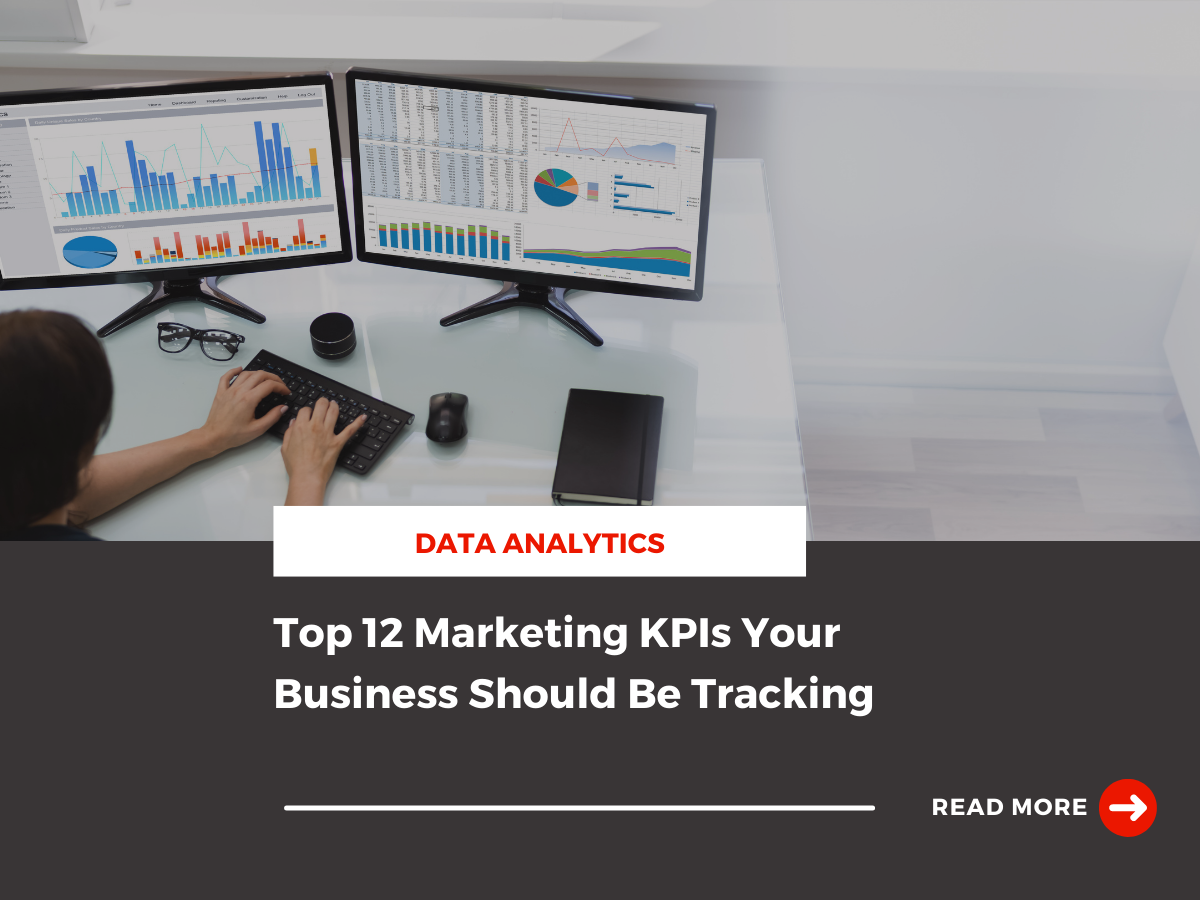There comes a time in every digital marketer’s career when they need to step back and analyze their marketing efforts. With the help of marketing KPIs, your business can assess the effectiveness of your marketing department and find new growth opportunities.
You may be wondering: Why is it so important to learn how to measure marketing performance?
KPIs for marketing help you see if your email marketing strategy resonates with your subscribers and if your subject lines are helping your open rate. They analyze the effectiveness of your UX design and if you need to revisit your landing page layouts.
By tracking this type of data regularly, you’ll find new opportunities and ways to improve that will impact your bottom line. If you aren’t keeping track of your KPIs on a regular basis, you can inefficiently spend your marketing budget.
Not sure where to start? Kanbar Digital is here to help.
Here’s everything you need to know about marketing key performance indicators and the top 12 you should use.
What is KPI in Marketing?
Key Performance Indicators (KPIs) are quantifiable measures that allow marketers to access and evaluate the performance of their marketing campaigns. These are integral to the decision-making process and help validate your marketing spending.
How to Pick The Best KPIs for Marketing
Once you’re ready to launch your next marketing campaign, you’ll want to take time to ensure you choose the best marketing KPIs for your needs.
Ask yourself:
- What is my goal?
- What results am I hoping to see?
- What do I want: More sales, leads, or subscriptions?
With these questions answered, you’ll better understand the impact of the data the KPIs will bring to you.
Top 12 Digital Marketing KPIs
Customer Acquisition Cost
CAC = (Total Marketing Expenses + Total Sales Expenses) / # of New Customers Acquired
Customer Acquisition Cost (CAC) is the total number of sales and marketing spent to bring in a new customer. This includes all marketing costs, salaries, technology, commissions, and anything else associated with turning a prospect into a paying customer.
Before calculating this KPI for marketing, you’ll need to decide if you want to look at your numbers MoM, QoQ, or YoY. The costs associated may be different for outbound marketing and digital marketing.
Here are a few things you’ll want to consider for both:
Digital Marketing
- Cost of Technology and Marketing Software
- Overhead
- Employee Salaries
Outbound Marketing
- Advertising Costs
- Employee Salaries
- Overhead
- Marketing Distribution Channels
Once you have your CAC, you can find ways to improve this cost. You may focus your efforts on Conversion Rate Optimization and enhancing your website design. Every small change you make will help eliminate pain points for your customers, convert more leads, and positively impact your bottom line.
Digital Marketing ROI
Digital Marketing ROI = (Sales Growth – Marketing Investment) / Marketing Investment
Understanding your return on investment with marketing initiatives will help you make crucial changes to your marketing strategy and budget choices for the next month, quarter, and year.
This digital marketing KPI allows you to keep an eye on what is and isn’t an effective use of your marketing budget. If you aren’t keeping an eye on your marketing ROI, you may waste your budget or inefficiently plan your campaigns.
Customer Lifetime Value
Customer Lifetime Value = The Initial cost to acquire a customer – The revenue earned for a customer
Customer Lifetime Value (CLV) helps you predict future profits your business will generate from each customer. Returning customers are considered to be more valuable than one-time purchasers. This is why you want to be creative and find new ways to satisfy your customers’ needs, to retain them. With your CLV, you can find new ways to improve your relationship with your current customers and estimate your cost per acquisition.
Return on Ad Spend
ROAS = (Amount Gained From Ads / Amount Spent on Ads) X 100
Return on Ad Spend (ROAS) looks at your ad campaigns and budget. This metric looks at how much revenue has been generated for every dollar you spend on an advertising campaign. It’s important to keep an eye on your ROAS to determine how much you get back from advertising.
Let’s break it down: If you made $100 on every $1 you spent on your last advertising campaign. That would mean your ROAS for that specific campaign would be 100:1.
Marketing Qualified Lead (MQL)
This is a common metric marketing teams use to measure the quality of leads they generate and pass to sales. If a customer is considered an MQL, they have shown interest in your brand but haven’t made a purchase. For example, these would be individuals that downloaded a free report, requested a demo, or filled out a contact form.
Your sales team will take this number and pop it into this equation:
MQL to SQL Conversion Rate = # of Sales Qualified Leads / # of Marketing Qualified Leads
This will help them measure the efficiency of their sales campaigns and how well they can convert MQLs to SQLs.
Email Open Rate
Email Open Rate = (The Number of Opened Emails / The Number of Emails Delivered) x 100
Your open rate refers to the percentage of newsletter subscribers opening your email campaigns. Keeping track of this measurement will help you evaluate your subject lines, the quality of your mailing list, and how engaged your customers are with your brand.
Click-Through Rate
Click-Through Rate = (The Number of Link Clicks / The Number of Emails Delivered) x 100
This is another email marketing KPI that you should keep an eye on. This one refers to the number of individuals that click on a link in an email. With this KPI, you can take a more strategic approach to your call-to-actions and find new ways to keep your subscribers engaged.
Keyword Ranking
Keywords impact how people find you organically and how your site ranks in search engines. The goal here is to show up on the first page of the search engine to improve your organic efforts.
On the Acquisition page in Google Analytics, you can see an overview of what people are searching when they find you and what keywords are used. GA will also show you your average keyword ranking position.
Pages Per Session
Pages Per Session = PageViews / Sessions
This digital marketing KPI is the average number of pages viewed during a single session a customer had on your website. To find this information, go to the Audience tab in Google Analytics and click overview. The number of pages per session will vary and depends on how many pages you currently have on your site. If the number is lower than you expected, it may be a sign you’ll want to create more content and revisit the CTAs on your web pages.
Website Visitors
Chances are, one of your main goals is to attract more website visitors to your website. There are two ways you can track this KPI for marketing: paid and organic.
If you’re tracking organic web traffic, it will help you understand your SEO initiatives. With web traffic contributed by paid efforts, you can better understand your PPC. You can also look at how many web referrals each platform brings to your site.
For example, if you see social media accounts have the least amount of web traffic, take a second look at your content. Consider revisiting your CTAs, adding more web links to your posts, or rethinking your social media and content strategy.
Audience Growth Rate
Audience Growth Rate = 100 X Net New Followers / Total Audience
If it’s your goal to keep growing, you’ll want to keep an eye on your audience growth rate across all social media channels. With this digital marketing KPI, you’ll see how well your content resonates with your audience and find new ways to grow. The goal here is to continue to gain new followers at a steady rate.
Engagement Rate
Engagement rate refers to how engaged your customers are with your brand across every social media platform. Understanding your engagement rate will help you know how much your content resonates with your audience. This KPI looks at the following:
- Likes, Shares, Reactions, and Saves
- Retweets and Social Shares
- Comments and Replies
These engagement analytics can be found in the social media platform under the analytics tab. You’ll want to pay attention to the types of content with the most engagement, so you can mimic the content throughout your social media strategy.
Start Tracking KPIs with Kanbar Digital
At Kanbar Digital, we want to help you get more from your marketing campaigns. Our team is pros at setting up KPIs and tracking them, so you don’t have to. We’ll help you build marketing campaigns that meet your specific needs and goals, so you can see the results you want to see over time.
To learn more, contact us today.




